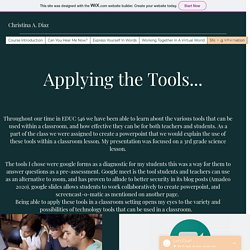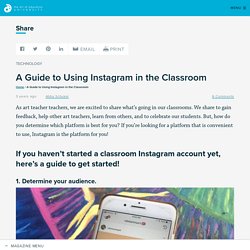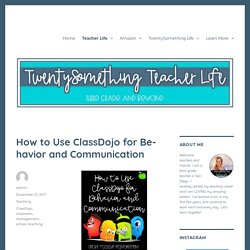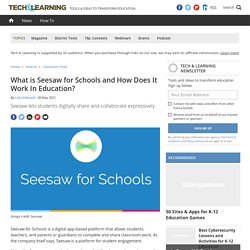

Christina A. Diaz Final Website. Throughout our time in EDUC 546 we have been able to learn about the various tools that can be used within a classroom, and how effective they can be for both teachers and students.

As a part of the class we were assigned to create a powerpoint that we would explain the use of these tools within a classroom lesson. My presentation was focused on a 3rd grade science lesson. The tools I chose were google forms as a diagnostic for my students this was a way for them to answer questions as a pre-assessment. Google meet is the tool students and teachers can use as an alternative to zoom, and has proven to allude to better security in its blog posts (Amadeo 2020). google slides allows students to work collaboratively to create powerpoint, and screencast-o-matic as mentioned on another page. Being able to apply these tools in a classroom setting opens my eyes to the variety and possibilities of technology tools that can be used in a classroom. Applying the Tools - Google Slides. My Google Form Survey. The many functions of Google ! Google Sheets. Create & grade quizzes with Google Forms.
Instagram in the Classroom. As art teacher teachers, we are excited to share what’s going in our classrooms.

We share to gain feedback, help other art teachers, learn from others, and to celebrate our students. But, how do you determine which platform is best for you? If you’re looking for a platform that is convenient to use, Instagram is the platform for you! If you haven’t started a classroom Instagram account yet, here’s a guide to get started! 1. When setting up your classroom Instagram account, it’s important to know your target audience.
If you’re an elementary art teacher, your audience will probably not be your students but rather other art teachers and parents. It’s ok to post for more than one group. For example, your students probably won’t care about how you store and organize your paint or label your Sharpies, but an art teacher might! 2. When it comes to social media in the school setting, it’s essential to know your school’s policies. Here are some vital pieces of information you will want to know: 3. How to Use ClassDojo for Behavior and Communication. If you are a teacher and you aren’t using ClassDojo, WHY NOT?

ClassDojo is one of my favorite technology tools that I use in my classroom. It is versatile and helps bridge the gap between school and home. If you aren’t using ClassDojo, or if you already use it and want to learn more about it, read on! ClassDojo is a multifunctional website/app designed to be used by teachers, parents, and students. Classroom Management When I first signed up for ClassDojo, it was for the sole purpose of positive reinforcement for classroom management.
Story Feed. Seesaw for the classroom. Seesaw for Schools is a digital app-based platform that allows students, teachers, and parents or guardians to complete and share classroom work.

As the company itself says, Seesaw is a platform for student engagement. Using the Seesaw app, students can show what they know using various media, from photos and videos to drawings, text, links, and PDFs. This is all on the Seesaw platform, meaning it can be seen and appraised by teachers and even shared with parents and guardians. The student portfolio grows over time, allowing them to carry it through their academic career.
This is a great way for other teachers to see how the student has progressed over time – even showing how they worked to get the final result. So how does Seesaw for Schools work for students and teachers? What is Seesaw for Schools? Seesaw for Schools allows students to work on a tablet or smartphone to create content that is automatically saved online within a personal profile. My Blog. My Screen Cast on youtube. Screen Recorder & Video Editor. The Flipped Classroom Model: A Full Picture. Due to Khan Academy’s popularity, the idea of the flipped classroom has gained press and credibility within education circles.
Briefly, the Flipped Classroom as described by Jonathan Martin is: Flip your instruction so that students watch and listen to your lectures… for homework, and then use your precious class-time for what previously, often, was done in homework: tackling difficult problems, working in groups, researching, collaborating, crafting and creating. Classrooms become laboratories or studios, and yet content delivery is preserved. Flip your instruction so that students watch and listen to your lectures… for homework, and then use your precious class-time for what previously, often, was done in homework: tackling difficult problems, working in groups, researching, collaborating, crafting and creating. Classrooms become laboratories or studios, and yet content delivery is preserved ( A compiled resource page of the Flipped Classroom (with videos and links) can be found at. Creating our own webpage.
Google Meet vs. Zoom - Which is Better?